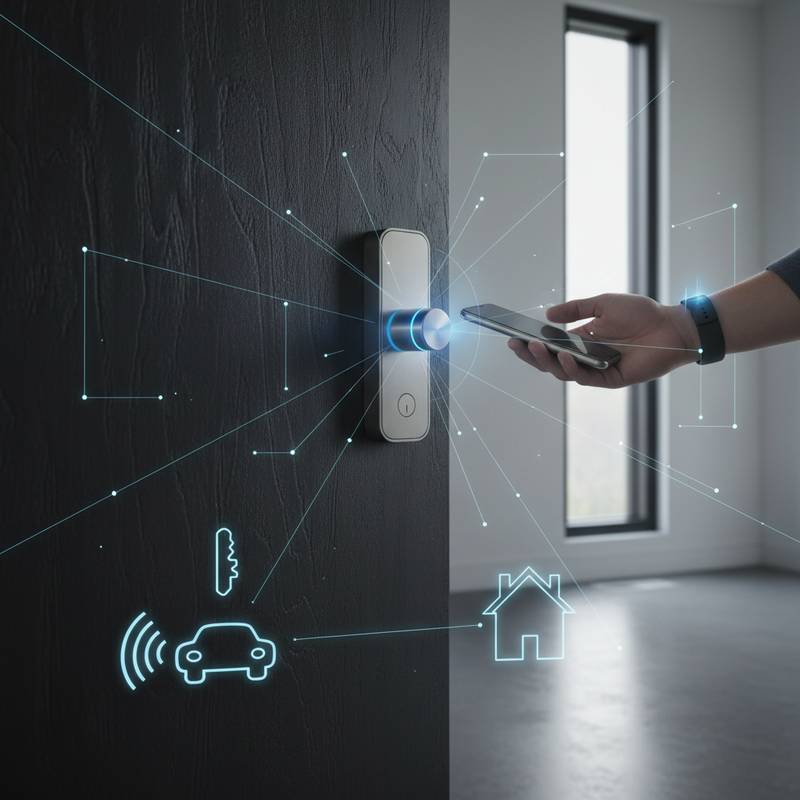The Evolution of Smart Locks with UWB Technology
Smart locks have advanced beyond simple keyless entry systems. They now incorporate Ultra-Wideband (UWB) technology, borrowed from automotive digital keys, to enable precise and automatic unlocking. This innovation allows doors to recognize and respond to your approach without manual intervention.
UWB operates by emitting short-range radio waves that measure distance with centimeter-level accuracy. Unlike Bluetooth, which can suffer from interference, or Wi-Fi, which requires broader connectivity, UWB ensures reliable performance in real-world conditions. Homeowners benefit from this precision, as it eliminates the need to pull out a phone or press a button.
How UWB Mimics Automotive Digital Keys
Car manufacturers introduced digital keys years ago to allow drivers to unlock and start vehicles using smartphones. These systems rely on UWB for secure, proximity-based authentication, preventing unauthorized access even if a phone is nearby in a bag or pocket. Smart locks apply the same principle to residential doors.
When you approach your front door with a compatible device, the lock detects the UWB signal and verifies your identity through encrypted communication. The door then unlocks automatically, much like a car door responds to the key fob. This process happens in milliseconds, providing a fluid experience that feels natural and intuitive.
Security remains paramount in this setup. UWB uses directional signals that are difficult to spoof, adding a layer of protection against relay attacks common in older wireless systems. As a result, your home gains the same level of safeguard that automakers provide for vehicles.
Key Benefits for Daily Home Access
The primary advantage of UWB smart locks lies in their convenience. Imagine returning home after a long day; the door unlocks as you walk up the path, allowing hands-free entry with groceries or packages in tow. This eliminates the frustration of searching for keys or navigating apps in low light or bad weather.
Security enhancements extend beyond automation. These locks log access events and integrate with home security systems to alert you of unusual activity. For families, shared access becomes simpler, as temporary permissions can be granted via the accompanying app without physical key handoffs.
Energy efficiency also plays a role. UWB requires minimal power, ensuring the lock operates reliably on battery life that lasts up to a year. This reliability reduces maintenance needs and keeps your entryway operational without frequent interventions.
Integrating Smart Locks with Your Existing Ecosystem
Most UWB smart locks connect to popular smart home platforms like Apple HomeKit, Google Home, or Amazon Alexa. This compatibility allows voice commands or automated routines, such as turning on lights when the door unlocks. Pairing with your car's digital key system creates a unified experience across your property.
For vehicle owners, brands like Apple CarKey or Android Digital Key enable cross-device functionality. Your iPhone or compatible Android phone serves as the central hub, syncing access between car and home. This integration fosters a connected lifestyle where devices communicate effortlessly.
Privacy features protect user data. Locks employ end-to-end encryption, and access logs are stored locally unless you choose to share them. Such measures ensure that your home remains a secure sanctuary in an increasingly digital world.
Step-by-Step Installation Guide
Installing a UWB smart lock follows a straightforward process that most homeowners can complete in under an hour. Begin by selecting a model compatible with your door type, such as deadbolt or lever styles. Gather tools like a screwdriver, drill, and the manufacturer's template.
- Remove the existing lock by unscrewing the interior and exterior components.
- Align the new lock's template on the door and mark drilling points if modifications are needed.
- Insert the UWB module into the door edge and secure the exterior keypad or reader.
- Mount the interior escutcheon and connect the battery pack.
- Download the app, pair the device via Bluetooth for initial setup, and calibrate the UWB range.
Test the system by walking toward the door with your phone. Adjust sensitivity settings in the app to fine-tune the unlocking distance, typically set between 1 to 3 meters. Professional installation services are available for those preferring assistance.
Selecting the Ideal UWB Smart Lock
Choose a smart lock based on your specific needs and home setup. Consider factors like battery life, weather resistance ratings, and integration options. Models from established brands offer warranties and customer support, ensuring long-term satisfaction.
Budget plays a role, with entry-level UWB locks starting around $200 and premium versions reaching $400. Evaluate additional features such as biometric fingerprint readers or video doorbells for enhanced functionality. Read user reviews focused on real-world UWB performance to inform your decision.
Compatibility with your smartphone ecosystem is crucial. iOS users should prioritize HomeKit-certified devices, while Android owners benefit from Matter-standard locks for broader interoperability. This selection process ensures the lock fits seamlessly into your digital routine.
Advancing Home Connectivity and Security
UWB smart locks represent a step toward fully automated homes. As technology evolves, expect deeper integrations with AI assistants for predictive access, like unlocking for expected guests based on calendar events. This progression enhances both convenience and control.
Homeowners who adopt these systems report fewer lost keys and quicker routines. The blend of automotive precision with residential security creates a robust solution for modern living. Ultimately, UWB locks empower you to focus on what matters, leaving the door to handle entry with effortless reliability.
